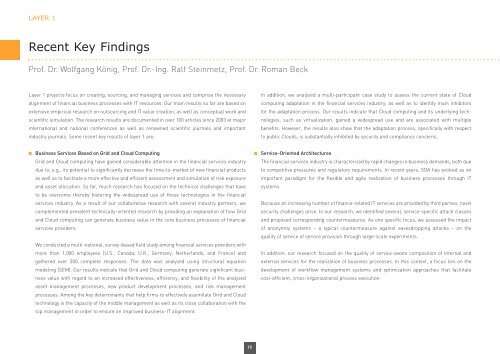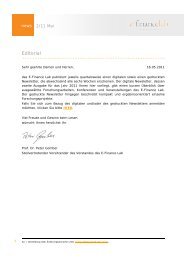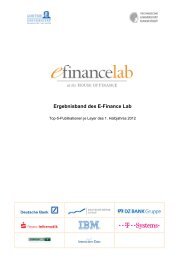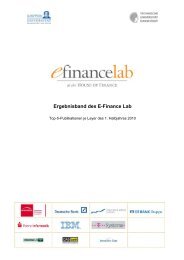The E-Finance Value Chain - E-Finance Lab Frankfurt am Main
The E-Finance Value Chain - E-Finance Lab Frankfurt am Main
The E-Finance Value Chain - E-Finance Lab Frankfurt am Main
You also want an ePaper? Increase the reach of your titles
YUMPU automatically turns print PDFs into web optimized ePapers that Google loves.
LAYER 1<br />
Recent Key Findings<br />
Prof. Dr. Wolfgang König, Prof. Dr.-Ing. Ralf Steinmetz, Prof. Dr. Roman Beck<br />
Layer 1 projects focus on creating, sourcing, and managing services and comprise the necessary<br />
alignment of financial business processes with IT resources. Our main results so far are based on<br />
extensive empirical research on outsourcing and IT value creation, as well as conceptual work and<br />
scientific simulation. <strong>The</strong> research results are documented in over 100 articles since 2003 at major<br />
international and national conferences as well as renowned scientific journals and important<br />
industry journals. Some recent key results of layer 1 are:<br />
n Business Services Based on Grid and Cloud Computing<br />
Grid and Cloud computing have gained considerable attention in the financial services industry<br />
due to, e.g., its potential to significantly decrease the time-to-market of new financial products<br />
as well as to facilitate a more effective and efficient assessment and simulation of risk exposure<br />
and asset allocation. So far, much research has focused on the technical challenges that have<br />
to be overcome thereby fostering the widespread use of these technologies in the financial<br />
services industry. As a result of our collaborative research with several industry partners, we<br />
complemented prevalent technically-oriented research by providing an explanation of how Grid<br />
and Cloud computing can generate business value in the core business processes of financial<br />
services providers.<br />
We conducted a multi-national, survey-based field study <strong>am</strong>ong financial services providers with<br />
more than 1,000 employees (U.S., Canada, U.K., Germany, Netherlands, and France) and<br />
gathered over 300 complete responses. <strong>The</strong> data was analyzed using structural equation<br />
modeling (SEM). Our results indicate that Grid and Cloud computing generate significant business<br />
value with regard to an increased effectiveness, efficiency, and flexibility of the analyzed<br />
asset management processes, new product development processes, and risk management<br />
processes. Among the key determinants that help firms to effectively assimilate Grid and Cloud<br />
technology is the capacity of the middle management as well as its close collaboration with the<br />
top management in order to ensure an improved business-IT alignment.<br />
15<br />
In addition, we analyzed a multi-participant case study to assess the current state of Cloud<br />
computing adaptation in the financial services industry, as well as to identify main inhibitors<br />
for the adaptation process. Our results indicate that Cloud computing and its underlying technologies,<br />
such as virtualization, gained a widespread use and are associated with multiple<br />
benefits. However, the results also show that the adaptation process, specifically with respect<br />
to public Clouds, is substantially inhibited by security and compliance concerns.<br />
n Service-Oriented Architectures<br />
<strong>The</strong> financial services industry is characterized by rapid changes in business demands, both due<br />
to competitive pressures and regulatory requirements. In recent years, SOA has evolved as an<br />
important paradigm for the flexible and agile realization of business processes through IT<br />
systems.<br />
Because an increasing number of finance-related IT services are provided by third parties, novel<br />
security challenges arise. In our research, we identified several, service-specific attack classes<br />
and proposed corresponding countermeasures. As one specific focus, we assessed the impact<br />
of anonymity systems – a typical countermeasure against eavesdropping attacks – on the<br />
quality of service of service provision through large-scale experiments.<br />
In addition, our research focused on the quality of service-aware composition of internal and<br />
external services for the realization of business processes. In this context, a focus lies on the<br />
development of workflow management systems and optimization approaches that facilitate<br />
cost-efficient, cross-organizational process execution.








